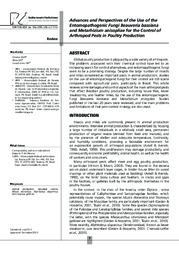Advances and perspectives of the use of the entomopathogenic fungi Beauveria bassiana and Metarhizium anisopliae for the control of arthropod pests in poultry production.
Advances and perspectives of the use of the entomopathogenic fungi Beauveria bassiana and Metarhizium anisopliae for the control of arthropod pests in poultry production.
Author(s): OLIVEIRA, D. G. P.; ALVES, L. F. A.; SOSA-GÓMEZ, D. R.
Summary: Global poultry production is plagued by a wide variety of arthropods. The problems associated with their chemical control have led to an increasing search for control alternatives, and entomopathogenic fungi seem to be a promising strategy. Despite the large number of insects and mites considered as important pests in animal production, studies on the use of entomopathogenic fungi for their control are still scarce compared with agricultural pests, particularly in Brazil. This article reviews some damages and control aspects of the main arthropod pests that affect Brazilian poultry production, including house flies, lesser mealworms, and feather mites, by the use of the entomopathogenic fungi Beauveria bassiana and Metarhizium anisopliae. Studies published in the last 20 years were reviewed, and the main problems and limitations of that pest-control strategy are discussed.
Publication year: 2014
Types of publication: Journal article
Unit: Embrapa Soybean
Keywords: Criação de aves
Observation
Some of Embrapa's publications are published as ePub files. To read them, use or download one of the following free software options to your computer or mobile device. Android: Google Play Books; IOS: iBooks; Windows and Linux: Calibre.
Access other publications
Access the Agricultural Research Database (BDPA) to consult Embrapa's full library collection and records.
Visit Embrapa Bookstore to purchase books and other publications sold by Embrapa.

